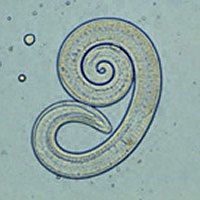
Photo from wikipedia
Trichinella is an important zoonotic parasite found in a range of wildlife species harvested for food and fur in Canada. We compared larval intensity from tongue and diaphragm, the best… Click to show full abstract
Trichinella is an important zoonotic parasite found in a range of wildlife species harvested for food and fur in Canada. We compared larval intensity from tongue and diaphragm, the best predilection sites in other animal species, from naturally infected, wild wolverines (Gulo gulo) (n = 95). Muscle larvae of Trichinella spp. were recovered by the pepsin/HCl artificial digestion method (gold standard) using double separatory funnels, and species were identified using multiplex PCR. Prevalence was 83% (79/95). Of those positive for Trichinella spp. (n = 79), 76 (96.2%) were detected in both tissues, 2 (2.5%) were positive only on diaphragm, and 1 (1.3%) only on tongue. A total of 62 of 79 wolverines (78.5%) had higher larval burden in tongue than in diaphragm, whereas 17 wolverines (21.5%) had higher larval burden in diaphragm. The predilection site (higher larval burden) of Trichinella spp. larvae did not vary significantly between juvenile and adult wolverines (P = 0.2), between male and female wolverines (P = 0.9), and among wolverines classified as having low and high larval intensities overall (P = 0.2). Trichinella T6 was the predominant genotype (63 of 79; 80%), followed by T. nativa (T2) (6 of 79; 8%). Mixed infections of T2 and T6 were observed in 9 of 79 (12%) wolverines. Larval intensity of Trichinella T6 was higher in tongues than diaphragms. No statement can be made for T2 due to insufficient T2 positive samples. In conclusion, tongues are a better site for sampling than diaphragms in future surveys of Trichinella larval intensity in wolverines; however, either tissue is suitable for prevalence studies.
Journal Title: Veterinary parasitology
Year Published: 2018
Link to full text (if available)
Share on Social Media: Sign Up to like & get
recommendations!